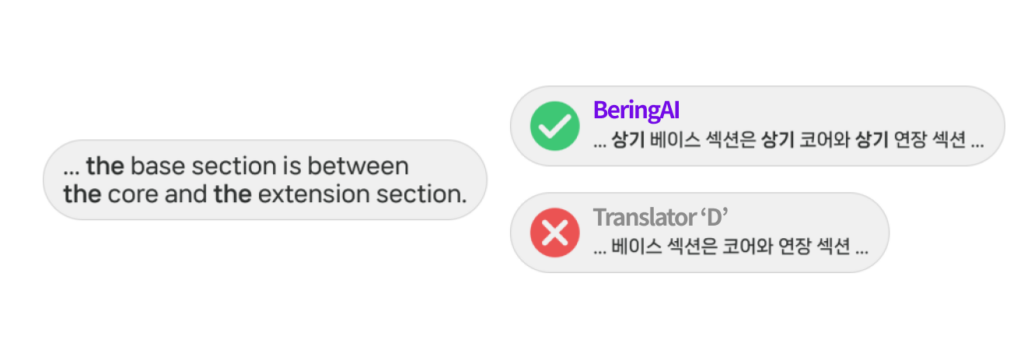Hello, and welcome to Bering Lab’s Translation Notes, where we share valuable insights into legal translation expertise. Today, we’re presenting the sixth post in our Bering Lab vs. Competitor comparison series, focusing on one of the most critical aspects of patent specifications: claim translation.
Patent specifications follow a unique translation sequence compared to general documents. While most documents are translated linearly—starting from the title, followed by the table of contents, and then the main body—patent specifications often begin with the “claims” section located at the end of the document. Why? The claims encapsulate the core technology and scope of the invention, serving as the foundation for the entire specification. Translating the claims first allows for consistency in the detailed description section later.
Claim translation forms the backbone of patent specifications. Once the claims are translated, the document’s overall structure is effectively established. Today, we’ll examine common expressions in claim translations through examples from Bering Lab and a competitor, determining which translation approach is more accurate and appropriate. Along the way, we’ll identify common mistakes, highlight areas for improvement, and explain why professional reviews are essential. We’ll also show how BeringAI+ can streamline this process.
✍🏻 BeringAI vs. Competitor Translations
[Original] The mandrel of claim 33, wherein the base section is between the core and the extension section.
[BeringAI] 제33항에 있어서, 상기 베이스 섹션은 상기 코어와 상기 연장 섹션 사이에 있는, 맨드릴.
[Competitor] 청구항 33의 맨드릴, 여기서, 베이스 섹션은 코어와 연장 섹션 사이에 위치한다.
✍🏻 Adhering to Claim Formatting Standards

Accurate claim translation requires a thorough understanding of the structural differences between Korean and English patent claims. These differences arise from linguistic characteristics and legal conventions, and careful attention to these nuances is crucial.
Korean patent claims are structured with the phrase “~항에 있어서” (In claim ~), and the subject of the invention must always appear at the end of the sentence. For example, “제3항에 있어서, 기판 상에 형성된 반도체층을 포함하는, 반도체 장치.” This format employs commas (,) and periods (.) in a distinct manner that diverges from typical Korean sentence-ending conventions.
English patent claims, on the other hand, follow a different approach. They introduce the subject matter at the beginning of the sentence and use “wherein” clauses to describe additional features. For instance, “The mandrel of claim 33, wherein…” is a standard format that maintains both readability and legal clarity.
During translation, reflecting these structural differences is vital. Translating “The mandrel of claim 33, wherein…” as “청구항 33의 맨드릴, 여기서…” (as seen in the competitor’s translation) is incorrect. Instead, Bering Lab correctly renders it as “제33항에 있어서, …는, 맨드릴.” This approach aligns with Korean patent conventions and ensures accuracy.
✍🏻 Should Articles Like ‘A’ and ‘The’ Be Explicitly Reflected?

Understanding and correctly translating English articles (“a” and “the”) is another critical aspect of patent translation. English uses articles to distinguish between new and previously introduced elements, while Korean lacks a direct equivalent.
Patent translators must carefully examine the document to determine whether a term refers to a new element or a previously mentioned one. For example, when translating claim 33, it’s essential to review claims 1 through 32 to understand the context and ensure consistent use of terms. The same term may refer to different elements in different claims, or different terms may describe the same component.
Bering Lab prioritizes this accuracy. While the competitor translated “the base section is between the core and the extension section” as “베이스 섹션은 코어와 연장 섹션 사이에” without explicit clarification, Bering Lab opted for “상기 베이스 섹션은 상기 코어와 상기 연장 섹션 사이에” to ensure legal clarity.
✍🏻 “Too Literal”? Patent Translations Must Be Precise

Patent specifications protect the technical content of inventions, making accuracy paramount. Unlike general translations, natural-sounding prose is secondary to technical and legal precision. Even a minor variation in expression can lead to entirely different interpretations.
The primary principle of patent translation is 1:1 correspondence. Adding or omitting information not present in the original is strictly forbidden. For instance, translating “is between A and B” as “A와 B 사이에 위치한” (as done by the competitor) is incorrect because the word “located” does not appear in the original text.
Bering Lab adheres strictly to these principles, translating the phrase faithfully as “~사이에 있는.”
How BeringAI+ Ensures Quality Patent Translation
BeringAI+ combines cutting-edge AI technology with expert legal reviews to deliver superior patent translation. With over 400 experienced patent attorneys and translators, BeringAI+ ensures:
- Accurate translation of over 30 languages simultaneously.
- Preservation of original formatting, minimizing the need for post-editing.
- Precise interpretation of claim formatting, article usage, and legal context.
We’re currently offering exclusive discounts for new corporate clients:
- 30% off for one translation project.
- 40% off for two or more projects.
To take advantage of this promotion, visit our website, click “Get a Free Quote,” and include “Startpack Promotion” in the “Requirements” field. Join the many global law firms and corporations already benefiting from BeringAI+’s expertise. As one client remarked, “The translation of our 20-page contract was completed astonishingly fast with only minor revisions needed.” Simplify your patent translation process with BeringAI+ today.

